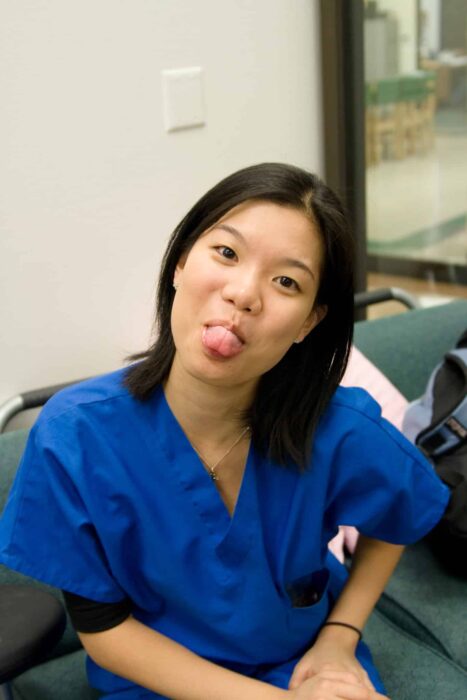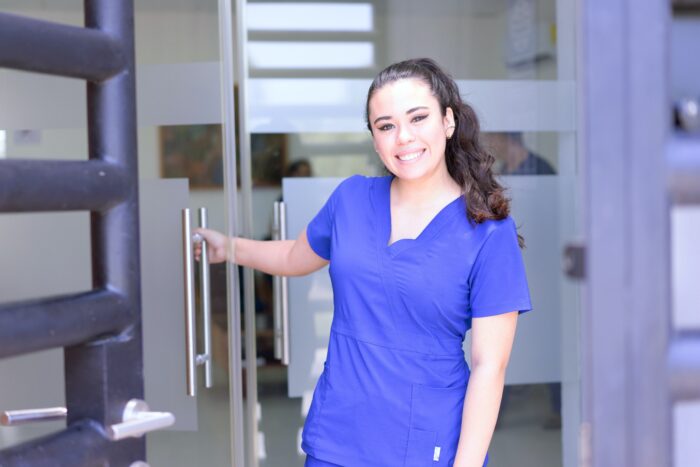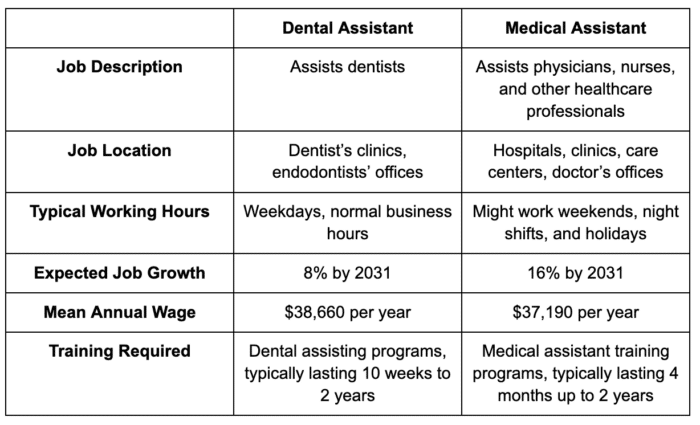If you want to enter the healthcare industry, you might be confused about which career to choose.
Both medical and dental assistants are promising careers to start with if you want to enter this industry sooner.
The demand for these careers has also been on the rise recently, making them ideal careers to step foot into.
So what is a medical assistant?
A medical assistant is a healthcare worker that provides support services to physicians, nurses, and other healthcare professionals.
Their duties include both administrative and clinical tasks, ranging from scheduling appointments to assisting physicians with bedside procedures.
See: 12 Reasons to Become a Medical Assistant
And what is a dental assistant?
A dental assistant assists dentists with procedures as well as administrative tasks. Their duties include assisting with extractions, fillings, and X-rays.
Read on to find out more about the similarities and differences between medical assistants and dental assistants, how to become one, and which might be the better-suited career for you.
Also see: Is Medical Assistant a Good Career?
Dental Vs. Medical Assistants: Overview
Medical assistants and dental assistants usually work together, with the main aim of delivering optimum care for the patients.
Let us take a look at a basic comparison between these two professions:
Medical Assistant: Overview
Medical assistants are trained professionals who work alongside physicians, nurses, and other healthcare professionals in various medical settings. They can work in primary care clinics, specialty practices, hospitals, and other healthcare facilities.
Their main role is to assist in patient care, and the main medical assistant job duties include:
- Taking vital signs such as blood pressure, temperature, and pulse
- Recording patient medical histories and updating medical records
- Preparing examination rooms and sterilizing medical instruments
- Assisting with medical procedures, such as minor surgeries and injections
- Performing basic laboratory tests, such as urine analysis and blood draws
- Administering medications as directed by the physician
- Providing patient education and instructions
- Handling administrative tasks such as answering phone calls, scheduling appointments, and processing billing and insurance claims.
Even though it is not usually required for medical assistants to be licensed or certified, employers highly prefer candidates who hold certifications.
Most medical assistants work in settings like physician offices, clinics, and outpatient care centers that are open during regular business hours.
However, some medical facilities such as hospitals, urgent care centers, and nursing homes may require medical assistants to work in shifts during evenings, weekends, and holidays to ensure patient care around the clock.
Also read: Where Can Medical Assistants Work?
Dental Assistant: Overview
Dental assistants work closely with dentists and other professionals to provide quality patient care. They may perform various clinical and administrative tasks to ensure the dental office runs smoothly and patients receive the necessary care.
Some of the most common responsibilities of dental assistants include:
- Assisting the dentist or hygienist during dental procedures, such as preparing instruments and materials, handing tools to the dentist, and suctioning fluids from the patient’s mouth.
- Taking and developing dental X-rays.
- Sterilizing and disinfecting instruments and equipment.
- Preparing and educating patients on dental procedures and post-operative care.
- Scheduling appointments and managing patient records.
- Assisting with administrative tasks, such as answering phones and ordering supplies.
- Applying topical anesthetics and fluoride treatments.
- Assisting with orthodontic procedures, such as placing and removing braces and wires.
- Educating patients on proper oral hygiene practices and providing preventive care instructions.
Most dental assistants work full-time during regular business hours, although some may work part-time or have flexible schedules.
Since dental offices are typically closed on weekends and holidays, dental assistants are usually not expected to work during those times.
Major Similarities Between Medical Assistants and Dental Assistants
Even though there are some differences, there are also many similarities between the two professions. One fundamental similarity is that both these careers aim to assist physicians and deliver care to patients.
Other similarities between these two include the following:
Ethical Responsibilities
This is one of the most important similarities between the two careers. Both medical and dental assistants are required to keep their patients safe at all times. In addition, they must also treat every patient equally.
Clinical & clerical tasks
Both these professions generally include administrative as well as clinical responsibilities. You have to perform clerical tasks which help in the smooth operations of the medical facility.
Supervision
Medical and dental assistants both work under the guidance of physicians.
Positive Job Outlook
As mentioned earlier, both of these careers are in demand, and their job outlook looks fairly positive, with medical assistants having 16% growth and dental assistants having 8% growth by the year 2031.
Major Differences (Dental Assistants Vs Medical Assistants)
We talked about the number of similarities both these professions have before; let us now take a look at the key differences between these two:
Job Location
Medical assistants have a wider range of job opportunities as they can work in various settings such as clinics, hospitals, and assisted living centers.
In contrast, dental assistants primarily work in dental offices and occasionally in an endodontic office. Therefore, medical assisting jobs offer more variety in terms of work environments.
Certification Requirements
The four principal organizations that offer medical assistant certifications are the American Association of Medical Assistants (AAMA), the American Medical Technologists (AMT),
the National Healthcareer Association (NHA), and the National Center for Competency Testing (NCCT). [NHA and AAMA are the most preferred organizations]
On the other hand, dental assistants become certified by completing the Certified Dental Assistant (CDA) program offered by the Dental Assisting National Board (DANB).
See more on: Medical Assistant Certificate Requirements
Number of jobs
According to the Bureau of Labor Statistics, as of May 2020, there were approximately 330,200 dental assistant jobs in the United States and about 725,200 medical assistant jobs.
Medical and Dental Assistants: Job Growth & Salary Comparison
According to the Bureau of Labor Statistics –
- Median Dental Assistant Salary -> $38,660
- Median Medical Assistant Salary -> $37,190.
However, the job outlook for medical assistants is better, with a projected job growth rate of 16% from 2019 to 2031, compared to a projected job growth rate of 8% for dental assistants over the same period.
Both medical and dental assisting can serve as stepping stones for those who want to advance their healthcare careers. Medical assistants can move up to become licensed practical nurses (LPNs) or registered nurses (RNs).
In contrast, dental assistants can become dental hygienists or even dentists after obtaining additional education and certifications.
Additionally, medical and dental assistants can transition to healthcare administration roles, such as medical or dental office managers, or pursue teaching opportunities to train future medical or dental assistants.
Also read: Certified Medical Assistant Salary
Educational Requirements {Medical Vs Dental Assistants}
While it is not legally required to be certified as a medical or dental assistant, many employers prefer to hire assistants who have completed a recognized certification program.
See: Certified Medical Assistant
The certification requirements and options vary depending on the type of assistant and the state you are in. In some states, medical assistants may need to be licensed or registered (Read: Registered Medical Assistant).
Additionally, some employers may require specific skills or experience, such as proficiency in a particular medical software or knowledge of specific dental procedures.
Read more on: Medical Assistant Educational Requirements
Therefore, it is important to research the requirements of your desired role and location to ensure you have the necessary qualifications to apply.
Also read: Are Medical Assistant Licenses Required?
Medical Assistant
In addition to completing an accredited program and passing an exam, some certification organizations may also require medical assistants to have a certain amount of work experience or continuing education credits to maintain their certification.
Medical assistance programs typically have minimum educational requirements, which usually include a high school diploma or GED.
These programs cover a range of topics, such as medical assistant terminology, anatomy and physiology, medical billing and coding, patient care techniques, and pharmacology.
Some programs also offer clinical experience through internships or externships. The length of the program can vary, with some programs taking as little as four months to complete, while others can take up to two years.
Also see: Medical Assistant Programs Cost
Dental Assistant
To become a certified dental assistant, individuals can complete an education program and pass three exams offered by the Dental Assisting National Board (DANB): the General Chairside Assisting, Radiation Health and Safety, and Infection Control exams.
The education program must be accredited by the Commission on Dental Accreditation (CODA).
Typically, dental assisting programs last between 6 and 12 months and require a high school diploma or equivalent (such as a GED) for admission.
The coursework covers basic anatomy, dental radiology, dental materials, infection control, and hands-on dental procedure training.
Also see: Accelerated Medical Assistant Program

Do You Want To Become a Medical Assistant? Check Out Free Medical Assistant Masterclass!
In our masterclass you learn:
- How to be a medical assistant faster…in just 4 months!
- Avoid student debt & driving to classes
- #1 thing employers want from Medical Assistants
- How to stand-apart & get a university certificate for a strong resume
Day in the Life of a Medical Assistant vs a Dental Assistant
Medical and dental assisting jobs can both be fast-paced and require assistants to be on their feet for extended periods. Both positions also require strong critical thinking, communication, and organizational skills to provide excellent patient care.
Also read: Medical Assistant On-the-Job Training
Medical Assistant: Typical Day
Medical assistants usually work full-time for 40 hours per week, with flexible shifts that may include early mornings, daytime, or evenings.
Their typical day begins by reviewing the schedule, sending appointment reminders to patients, and managing payment reminders and supplies inventory.
Upon the first patient’s arrival, they usually first check them in, prepare their room, and help gather their health history while potentially measuring vital signs like blood pressure and temperature.
The medical assistant’s duties also include assisting the doctor during an assessment and carrying out minor procedures as needed. They may also take blood, urine, or saliva samples for lab tests.
Also see: Can Medical Assistants Draw Blood?
Once the appointment is over, they assist the patient with check-out procedures, explain prescription information and schedule a follow-up appointment.
After the patient leaves, they clean and sanitize the examination room and equipment in preparation for the next patient.
Read more on: Medical Assistant Hours
Dental Assistant: Typical Day
Dental assistants usually work regular hours on weekdays, typically starting in the morning and finishing in the late afternoon or early evening. They do not normally work on weekends or holidays.
At the beginning of the day, dental assistants may check the appointment schedule and send reminders to patients. They will then set up each examination room with clean and sterilized equipment and tools for the dentist to use.
Once a patient arrives for their appointment, the dental assistant will accompany them to the exam room and provide information about what will happen during the visit. They will update the patient’s medical history and inquire about any concerns.
During the exam, the dental assistant assists the dentist by providing them with tools, maintaining the patient’s mouth’s cleanliness and dryness using suction hoses, and following the dentist’s instructions.
They may also administer numbing gel, take X-rays, or create molds of the teeth as needed.
After the procedure, the dental assistant is responsible for cleaning the room and sanitizing any equipment that was used. They can ensure that the patient understands any post-procedure instructions and schedule follow-up appointments if necessary.
How To Choose Between a Medical Assistant or a Dental Assistant Career?
You can research more about the duties and responsibilities of each position and the education and certification requirements in your state. Consider your personal interests and strengths, as well as your long-term career goals, before making a decision.
Here is more on: Medical Assistant Scope of Practice by State
It may also be helpful to talk to professionals in each field, such as medical and dental assistants, to gain insight into their experiences and get advice on getting started in the industry.
By taking the time to research and explore your options, you can make an informed decision and set yourself up for a successful career in the medical field.
Also see: How to get Medical Assistant jobs with no experience
Also See PREPPY’S incredible ONLINE DENTAL ASSISTANT TRAINING PROGRAM HERE.
Conclusion
Wrapping up the comparison between medical assistants and dental assistants, it’s clear that while they share some similarities in supporting healthcare, they work in distinct fields with unique responsibilities. Medical assistants operate in broader healthcare settings, handling a mix of administrative tasks and clinical duties, supporting various medical specialties.
On the other hand, dental assistants focus specifically on oral health, aiding dentists with procedures, patient care, and office tasks in dental practices. Understanding these differences helps individuals choose the path that aligns best with their interests and career goals within the healthcare field.
Related Resources:
- Medical Assistant vs Nurse
- CMA vs CNA
- Medical Assistant vs Phlebotomist
- CMAA vs CCMA
- How To Become a Medical Assistant?
- How Long Does It Take to Become a Medical Assistant?
- Medical Assistant vs EMT
- National Certified Medical Assistant NCMA
- Medical Assistant Courses
- Cheapest Medical Assistant Program
Related Articles
-
How to Be Successful in College in 2022 – 7 Simple Tips to Succeed
-
How Do Scholarships Work? Read This First…Truth is Shocking
-
7 Best College Majors 2024: What Should I Major In?
-
How to Choose a College – 10 Things You Must Consider in 2024
-
Why Go to College? Top 13 Benefits for Adult Students in 2022
-
Top 5 Best Alternatives to Community College for 2024












